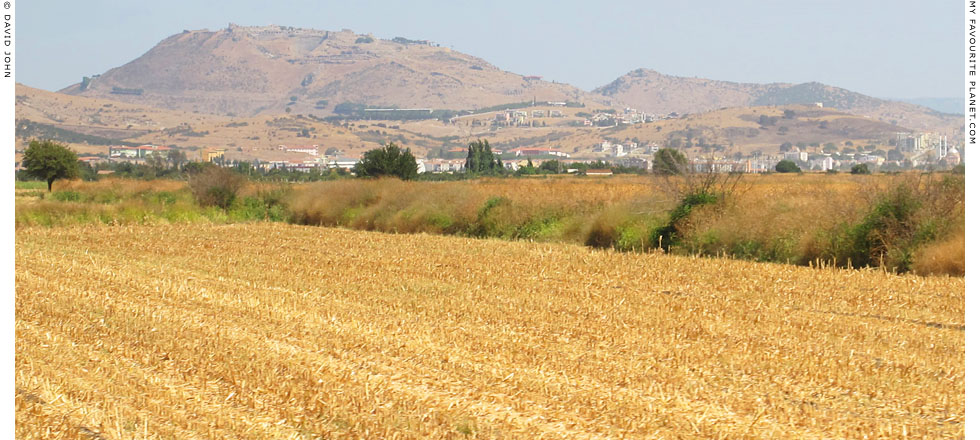The 300 metre high acropolis of ancient Pergamon towers over the modern town of Bergama which lies in the broad plain of the Bakır Çayı river (the ancient Kaikos). Two tributaries of the river pass on either side of the Acropolis: to the west the Bergama Çayı (the ancient Selinus) which flows through Bergama (see gallery pages 3 and 8); and to the east the Kestel Çayı (the ancient Ketios) which was damned in 1992 below the acropolis to form an artificial U-shaped lake (see gallery pages 25 and 26).
The visual effect of the steep-sided hill rising from the plain and crowned with ancient ruins is quite impressive, and the view of the surrounding landscape from the top of the Acropolis can be breathtaking, especially when a clear sky lets the Aegean light work its magic.
The defensive advantages of the site made it an obvious place to build a fortress city in ancient times. The Hellenistic city of Pergamon was founded in the 4th century BC as a treasury for much of Alexander the Great's war booty (see History of Pergamon).
The Greeks and Romans built their cities to impress, and as in Ephesus, ever more grand gleaming buildings, including temples, gymnasia, market places, theatres, palaces and the famous Pergamon Library, were added during antiquity to dazzle visitors and assert wealth and cultural superiority. While Pergamon's temples were not on the huge scale of the Temple of Artemis at Ephesus or even the Parthenon in Athens, the collective effect of this city's buildings and their situation, particularly the theatre, must have been pretty awe-inspring.
Today, Bergama is a typical Anatolian market town in whose narrow streets you are just as likely to see tractors and pickup trucks full of watermelons as tourist coaches. The northern end of the town (the old town) lies at the foot of the acropolis, near the river, over which the main street Bankalar Cad leads southwest towards the nearby coastal resort Ayvalik and the regional capital Izmir.
The ruin of the enormous Roman Red Basilica (Kızıl Avlu, also known as the Red Hall and the Temple of Serapis) sits astride the Bergama Çayı river. Like the name says, the ancient temple is very red, having been built in the 2nd century AD from large flat ceramic bricks.
Near the Red Basilica is the smaller of the town's two bus stations (otogar), for buses heading north and east of Bergama. The new main otogar is 7 km southwest of the centre of Bergama, on the highway to Izmir.
The ruins of the Asklepieion (Asclepion), the ancient healing centre of Pergamon, are 2 km west of Bergama town centre.
Visiting the sights of Pergamon can easily take a whole day, but if possible it worth stretching it out to at least two days. Although it is a small town, Bergama is pleasant place with a few good, reasonably priced restaurants, hotels and pensions. It also has a couple of Ottoman mosques, the Kurşunlu Cami and Ulu Cami, hamams, and some pleasant footpaths around the local farmland.
Some of the other sights of Bergama:
• The old quarter, with traditional Ottoman-style houses
• Selçuk Minaret, 14th century
• Çukurhan caravanserai, 14th century
• Taşhan caravanserai, 1432
• Great Mosque of Bergama, 1399
• Haci Hekim Hamami (Turkish bath), 1513
• Şadırvanlı Mosque, 1550
Many of the Pergamon's historical treasures can be found in the town's excellent archaeological museum. Other archaeological finds, such as the
Great Altar of Zeus (also known as the Pergamon Altar), are now in the Pergamon Museum, Berlin, on which we will be reporting soon.






















